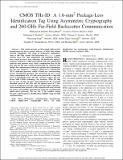CMOS THz-ID: A 1.6-mm² Package-Less Identification Tag Using Asymmetric Cryptography and 260-GHz Far-Field Backscatter Communication
Author(s)
Khan, Muhammad Ibrahim Wasiq; Ibrahim, Mohamed I.; Juvekar, Chiraag; Jung, Wanyeong
DownloadAccepted version (6.480Mb)
Open Access Policy
Open Access Policy
Creative Commons Attribution-Noncommercial-Share Alike
Terms of use
Metadata
Show full item recordAbstract
This article presents an ultra-small, high-security identification tag that is entirely built in a CMOS chip without external components. The usage of backscatter communications at 260 GHz enables full integration of a 2×2 patchantenna array. For chip compactness and minimum interference caused by direct wave reflection, the backscatter signal is frequency-shifted by 2 MHz and radiated with cross polarizationfrom the same antenna array. Such a configuration also, for thefirst time for RF tags, enables beamsteering for enhanced linkbudget. For authentication and secure wireless data transmission, the tag also integrates a compact elliptic-curve-cryptography(ECC) dedicated processor, which is based on a narrow-strongprivate identification protocol. The presented tag has a peakpower consumption of 21μW and can be powered by a chip-widearray of photodiodes and a DC–DC converter. Using a low-cost65-nm bulk CMOS technology, the erahertz (THz) ID chiphas an area of only 1.6 mm2 and demonstrates the measured downlink speed of 100 kb/s and the upload speed of 2 kb/sacross 5-cm distance from the reader. The tag-reader authentica-tion/communication protocol is fully demonstrated using externaltag power and partially demonstrated using the tag-integratedphoto-voltaic powering. The tag size is the smallest amongall prior radio-frequency identifications (RFIDs) using far-field communications.
Date issued
2020-08Department
Massachusetts Institute of Technology. Department of Electrical Engineering and Computer Science; Massachusetts Institute of Technology. Microsystems Technology LaboratoriesJournal
IEEE Journal of Solid-State Circuits
Publisher
Institute of Electrical and Electronics Engineers (IEEE)
Citation
Khan, Muhammad Ibrahim Wasiq et al. “CMOS THz-ID: A 1.6-mm² Package-Less Identification Tag Using Asymmetric Cryptography and 260-GHz Far-Field Backscatter Communication.” IEEE Journal of Solid-State Circuits 99 (August 2020): 1 © 2020 The Author(s)
Version: Author's final manuscript
ISSN
0018-9200
1558-173X